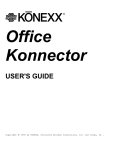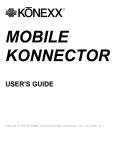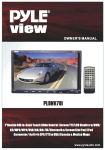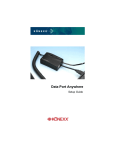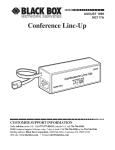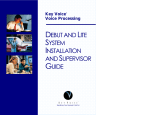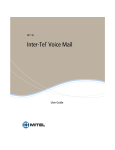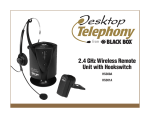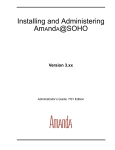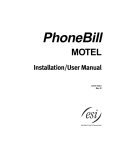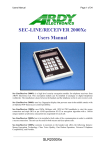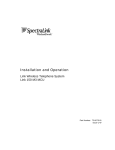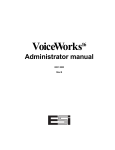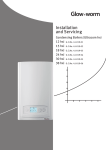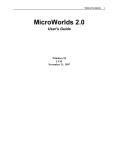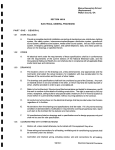Download MC160A(E)-R2 Manual
Transcript
AUGUST 1999 MC160A-R2 MC160AE-R2 Auto Linc Up CUSTOMER SUPPORT INFORMATION Order toll-free in the U.S. 24 hours, 7 A.M. Monday to midnight Friday: 877-877-BBOX FREE technical support, 24 hours a day, 7 days a week: Call 724-746-5500 or fax 724-746-0746 Mail order: Black Box Corporation, 1000 Park Drive, Lawrence, PA 15055-1018 Web site: www.blackbox.com • E-mail: [email protected] AUTO LINC UP FCC REQUIREMENTS FOR TELEPHONE-LINE EQUIPMENT 1. The Federal Communications Commission (FCC) has established rules which permit this device to be directly connected to the telephone network with standardized jacks. This equipment should not be used on party lines or coin lines. 2. If this device is malfunctioning, it may also be causing harm to the telephone network; this device should be disconnected until the source of the problem can be determined and until the repair has been made. If this is not done, the telephone company may temporarily disconnect service. 3. If you have problems with your telephone equipment after installing this device, disconnect this device from the line to see if it is causing the problem If it is, contact your supplier or an authorized agent. 4. The telephone company may make changes in its technical operations and procedures. If any such changes affect the compatibility or use of this device, the telephone company is required to give adequate notice of the changes. 5. If the telephone company requests information on what equipment is connected to their lines, inform them of: a. The telephone number that this unit is connected to. b. The ringer equivalence number. c. The USOC jack required: RJ-11C. d. The FCC registration number. Items (b) and (d) can be found on the unit’s FCC label. The ringer equivalence number (REN) is used to determine how many devices can be connected to your telephone line. In most areas, the sum of the RENs of all devices on any one line should not exceed five (5.0). If too many devices are attached, they may not ring properly. 6. In the event of an equipment malfunction, all repairs should be performed by your supplier or an authorized agent. It is the responsibility of users requiring service to report the need for service to the supplier or to an authorized agent. 1 AUTO LINC UP NORMAS OFICIALES MEXICANAS (NOM) ELECTRICAL SAFETY STATEMENT INSTRUCCIONES DE SEGURIDAD 1. Todas las instrucciones de seguridad y operación deberán ser leídas antes de que el aparato eléctrico sea operado. 2. Las instrucciones de seguridad y operación deberán ser guardadas para referencia futura. 3. Todas las advertencias en el aparato eléctrico y en sus instrucciones de operación deben ser respetadas. 4. Todas las instrucciones de operación y uso deben ser seguidas. 5. El aparato eléctrico no deberá ser usado cerca del agua—por ejemplo, cerca de la tina de baño, lavabo, sótano mojado o cerca de una alberca, etc.. 6. El aparato eléctrico debe ser usado únicamente con carritos o pedestales que sean recomendados por el fabricante. 7. El aparato eléctrico debe ser montado a la pared o al techo sólo como sea recomendado por el fabricante. 8. Servicio—El usuario no debe intentar dar servicio al equipo eléctrico más allá a lo descrito en las instrucciones de operación. Todo otro servicio deberá ser referido a personal de servicio calificado. 9. El aparato eléctrico debe ser situado de tal manera que su posición no interfiera su uso. La colocación del aparato eléctrico sobre una cama, sofá, alfombra o superficie similar puede bloquea la ventilación, no se debe colocar en libreros o gabinetes que impidan el flujo de aire por los orificios de ventilación. 2 AUTO LINC UP 10. El equipo eléctrico deber ser situado fuera del alcance de fuentes de calor como radiadores, registros de calor, estufas u otros aparatos (incluyendo amplificadores) que producen calor. 11. El aparato eléctrico deberá ser connectado a una fuente de poder sólo del tipo descrito en el instructivo de operación, o como se indique en el aparato. 12. Precaución debe ser tomada de tal manera que la tierra fisica y la polarización del equipo no sea eliminada. 13. Los cables de la fuente de poder deben ser guiados de tal manera que no sean pisados ni pellizcados por objetos colocados sobre o contra ellos, poniendo particular atención a los contactos y receptáculos donde salen del aparato. 14. El equipo eléctrico debe ser limpiado únicamente de acuerdo a las recomendaciones del fabricante. 15. En caso de existir, una antena externa deberá ser localizada lejos de las lineas de energia. 16. El cable de corriente deberá ser desconectado del cuando el equipo no sea usado por un largo periodo de tiempo. 17. Cuidado debe ser tomado de tal manera que objectos liquidos no sean derramados sobre la cubierta u orificios de ventilación. 18. Servicio por personal calificado deberá ser provisto cuando: A: El cable de poder o el contacto ha sido dañado; u B: Objectos han caído o líquido ha sido derramado dentro del aparato; o C: El aparato ha sido expuesto a la lluvia; o D: El aparato parece no operar normalmente o muestra un cambio en su desempeño; o E: El aparato ha sido tirado o su cubierta ha sido dañada. 3 AUTO LINC UP TRADEMARKS The trademarks mentioned in this manual are the sole property of their owners. 4 AUTO LINC UP CONTENTS 1. Specifications. . . . . . . . . . . . . . . . . . . . . . . . . . . . . . . . 7 2. Quick Start. . . . . . . . . . . . . . . . . . . . . . . . . . . . . . . . . . 8 2.1 Setting the Modem to Ignore Dial Tone. . . . . . . 8 2.2 Connecting the Auto Linc Up to a Telephone. . 8 2.3 Manual Dialing with Auto Linc Up . . . . . . . . . . . 9 3. Introduction . . . . . . . . . . . . . . . . . . . . . . . . . . . . . . . . 11 3.1 General. . . . . . . . . . . . . . . . . . . . . . . . . . . . . . . . . . 11 3.2 About this Manual. . . . . . . . . . . . . . . . . . . . . . . . . 11 3.3 What the Package Includes . . . . . . . . . . . . . . . . . 12 3.4 Preinstallation Guidelines . . . . . . . . . . . . . . . . . . 13 4. Installation. . . . . . . . . . . . . . . . . . . . . . . . . . . . . . . . . . 14 4.1 Connection Procedures . . . . . . . . . . . . . . . . . . . . 14 5. Telephone Auto Dial Chart . . . . . . . . . . . . . . . . . . . . 16 6. Sending Data and Faxes . . . . . . . . . . . . . . . . . . . . . . . 22 6.1 Autodialing Data and Fax Calls . . . . . . . . . . . . . . 22 6.2 Dialing Data Calls Manually . . . . . . . . . . . . . . . . . 24 6.3 Dialing Fax Calls Manually . . . . . . . . . . . . . . . . . . 27 5 AUTO LINC UP 7. Receiving Data and Faxes. . . . . . . . . . . . . . . . . . . . . . 30 7.1 Receiving a Data File. . . . . . . . . . . . . . . . . . . . . . . 30 7.2 Receiving a Fax Document. . . . . . . . . . . . . . . . . . 31 8. Operating Tips . . . . . . . . . . . . . . . . . . . . . . . . . . . . . . 33 8.1 Powering the Linc Up. . . . . . . . . . . . . . . . . . . . . . 33 8.2 Tone Dialing . . . . . . . . . . . . . . . . . . . . . . . . . . . . . 33 8.3 V.34/V.FAST Connections . . . . . . . . . . . . . . . . . . 33 8.4 Speakerphones . . . . . . . . . . . . . . . . . . . . . . . . . . . 34 8.5 Princess and Trimline Telephones . . . . . . . . . . . 34 8.6 Hanging Up the Modem . . . . . . . . . . . . . . . . . . . 34 8.7 “No Dial Tone” Error Message . . . . . . . . . . . . . . 35 8.8 Autodialing . . . . . . . . . . . . . . . . . . . . . . . . . . . . . . 36 8.9 Calling Technical Support . . . . . . . . . . . . . . . . . . 38 6 AUTO LINC UP 1. Specifications Compatibility — Compatible with V.34 modems Speed — Up to 33.6 kbps Temperature — Operating: -40 to 158 °F (-40 to 70 °C); Storage: -40 to 239 °F (-40 to 115 °C) Humidity — 5 to 95%, non-condensing Indicators — None Connectors — Handset: (1) RJ-22 female; Data connector: (1) RJ-11; (1) RJ-22 on pigtail Power — MC160A-R2: 120 VAC, 60 Hz; MC160AE-R2: 230 VAC, 50 Hz Size — 5.1"H x 2.9"W x 1.1"D (12.9 x 7.4 x 2.8 cm) Weight — Product weight: 0.5 lb. (0.2 kg); Shipping weight: 1.3 lb. (0.6 kg) 7 AUTO LINC UP 2. Quick Start This chapter describes how to manually calibrate and dial using the Auto Linc Up. If you would like to know about other ways of using the Linc Up, read the rest of this manual. Follow these steps: 1. Set your modem to ignore dial tone. 2. Connect the Auto Linc Up to a telephone. 3. Calibrate the Auto Linc Up. 4. Manually dial the number you wish to connect to. 2.1 Setting the Modem to Ignore Dial Tone Refer to your communications software manual or Section 6.2, Dialing Data Calls Manually, if you don’t know how to set your modem to ignore dial tone. 2.2 Connecting the Auto Linc Up to a Telephone To connect your Auto Linc Up to a telephone, see Figure 2-1. 8 AUTO LINC UP Phone Jack at the Wall Fax/Modem Line Jack PC or Macintosh Digital, PBX, or Multiline Phone Handset Jack AC Power at the Wall AC Adapter Figure 2-1. Connecting the Auto Linc Up to a Telephone. Using the AC adapter is optional; the Auto Linc Up also works with batteries (supplied). 2.3 Manual Dialing with the Auto Linc Up With the telephone handset in the cradle (hung up), have your modem dial. After your modem has dialed, lift the handset and manually dial the number you are trying to connect with using the keypad of the telephone. Leave the handset out of the cradle for the entire communication process. When you are finished with the call, hang up the telephone. 9 AUTO LINC UP • Remember, if you are operating the Auto Linc Up from batteries, you must take your modem off hook (start your connection) within one minute of calibrating the Linc Up. • Make sure your modem is set to ignore dial tone. NOTE If you cannot set your modem to ignore dial tone, refer to the standard procedure, beginning with Chapter 3. 10 AUTO LINC UP 3. Introduction 3.1 General The Auto Linc Up provides a data communications interface between your fax/modem and virtually any PBX or multiline telephone. You can connect the Linc Up in seconds simply by removing the coiled handset cord from the telephone base, connecting the Linc Up to your telephone base, then connecting the handset (with coiled cord attached) and your communications device to the Auto Linc Up (see Figure 2-1). The Auto Linc Up is compatible with V.34 modems and can support connection rates up to 33.6 kbps. 3.2 About This Manual This manual contains seven chapters. • Chapter 1 lists specifications for the Linc Up. • Chapter 2 is a Quick-Start Guide to get your system set up quickly. 11 AUTO LINC UP • Chapter 3 (this chapter), Introduction, provides general information about the Auto Linc Up, describes the contents of each chapter in this manual, lists the package contents, and provides preinstallation guidelines. • Chapter 4, Telephone Autodial Chart, provides guidelines for autodialing. • Chapter 5 describes how to send data and faxes. • Chapter 6 describes how to receive data and faxes. • Chapter 7 provides operating tips. 3.3 What the Package Includes Your package should include the following items. If anything is damaged or missing, please contact Black Box immediately at 724-746-5500. • (1) Auto Linc Up unit • (1) AC adapter (115-VAC for MC160A-R2, 230-VAC for MC160AE-R2) • This user manual 12 AUTO LINC UP 3.4 Preinstallation Guidelines Please read the complete manual and then return to those sections that suit your needs. Before installing your Auto Linc Up, observe these guidelines: • Connection}—Never connect the Auto Linc Up directly to an analog or digital telephone line (wall outlet). Follow the procedures in this user guide to avoid damaging your Linc Up. • Dialing—Configure your fax/modem for Tone dialing. • Speakerphones—If the attached telephone has speakerphone capability, do not use the speakerphone function when using your fax/modem. This mode deactivates the handset jack used to send and receive data. • Speaker Control and Volume—The telephone handset is deactivated during dialing. If you use a modem or fax/modem, you can use the command to enable the modem speaker and the command to set its volume. You can then “listen in” on dialed calls to monitor their status. Refer to your modem manual for more information. 13 AUTO LINC UP 4. Installation 4.1 Connection Procedures To connect your Auto Linc Up to a telephone, refer to Figure 2-1 on page 9 and follow the steps listed below. 1. Remove the spiral handset cord from the handset jack on the telephone base unit and insert it into the Auto Linc Up connector jack labeled HANDSET. 2. Insert the Linc Up’s modular telephone cord (which is permanently attached at one end to the Linc Up) into the handset jack on the telephone base unit. 3. Connect a modular telephone cord from your modem, fax/modem, or fax machine jack labeled “Line” or “Wall” to the Linc Up connector jack labeled DATA. 4. If you’re using the supplied AC adapter, connect the round end to the jack labeled to the jack labeled DC on the Auto Linc Up and the other end to an AC outlet. 14 AUTO LINC UP Your installation should resemble the one shown in Figure 2-1 on page 9. 5. Lift the telephone handset and listen for a dial tone. If you do not hear the dial tone, check your connections to make sure they match those shown in Figure 2-1. 6. When your modem, fax/modem, or fax machine is not in use, you can use the telephone normally. 15 AUTO LINC UP 5. Telephone Autodial Chart A “Yes” in the “AUTODIAL” column indicates that autodialing is supported with that telephone model. The number in the “SEE NOTE” column refers to a note at the end of the table. Manufacturer Model Autodial Ameritech None Specified Yes Lucent (AT&T) Definity Destiny Dimension G2 Horizon ISDN Infinity Legend Merlin Merlin II Partner Spirit System 25 System 75 System 85 Yes — — Yes Yes No Yes No Yes — Yes Yes Yes Yes Yes Comdial Digitech Executech Impact Yes Yes Yes David Systems None Specified — Eagle None Specified Yes Ericson MD110 Yes 16 *See NOTES on page 21. See Note* 4 2 2 8 2 3&4 3&4 3&4 2 AUTO LINC UP Manufacturer Model Autodial See Note* Executone Encore CX IDS Model 228 Model 432 Key Systems No No No No Yes 8 9 8 8 Fujitsu Focus 196 Others No Yes 5 GAI-Tronics Cohort No 8 Harris Lanier Optic Yes No Hitachi Digital Model 200 HCX-5000 — — 2 2 Intecom IBX System Hitech/1232 No Yes 8 4 Intertel MPK-2 Axxess Premier Others — No No Yes 2 8 Isoetec Key Systems Digital PBX Yes — 2 ITT None Specified — 2 Iwatsu Omega Omega III Omega IV Yes Yes Yes 4 Kanda Yes Kokyo Co. *See NOTES on page 21. 17 AUTO LINC UP Manufacturer Model Autodial Lanier EKT-220 (Elec. Key) Yes Lexar Telex No Macrotel None Specified Yes Mitel Superset SX-200 No No NEC Determ II Determ III Determ V Electra Freedom Mark II Others Yes — Yes No Yes Yes Yes Nitsuko Onyx — Northcom Premier (NC-1648) Yes Northern Telecom Advantage Focus Logic One Meridian SL1 & SL100 Meridian 1 Norstar DR5 or DID Unity Vantage Yes No No No No Yes Yes Yes — Panasonic KXT2375 DBS Others Yes Yes Yes Phillips Sopho Set Executive — 18 *See NOTES on page 21. See Note* 6&8 8 8 2 8 2 7 8 8 8 8 2 2&6 AUTO LINC UP Manufacturer Model Autodial See Note* Premier Digital Yes 7 Rolm Model 120 Model 240 Model 244 Model 312 Model 400 Model 600 Model 612 Model 620 Model 624 Others No No No No No No No No No No 8 8 8 8 8 8 8 8 8 8 Siemens Dyad Dyad Jr. HCM-600 HCM-200 Hicom Digital Saturn Digit 260 No No — — — — 6&8 6&8 2 2 2 5 Southwestern Bell Freedom Phone-Older Freedom Phone-Newer Yes Yes 1 SRX Vision Phone — 2 Tadiran EKT 221 Emerald Coral I & II Others Yes — — Yes 2 2 Model 816 Model 2484 Symphony Digital (818) Others Yes Yes No No — Telrad *See NOTES on page 21. 8 8 2 19 AUTO LINC UP Manufacturer Model Autodial See Note* TIE Business Comm Datastar DCX Meritore Onyx TC22 EX2260 Ultracom CX Keyset 9 — Yes Yes Yes Yes Yes Yes — — 2 EKT 2000 series EKT 3000 series EKT 6000 series Perception Strata (Key system) 103 series Yes — Yes No — Yes Trillium Panther Talkto 616 — — Vodavi Electronic Key System Star Plus Yes Yes Walker Marathon Poet Yes Yes Toshiba 20 *See NOTES on page 21. 2 2 2 8 2 2 2 AUTO LINC UP NOTES 1. If you encounter difficulties, contact Technical Support. 2. Insufficient data is available to determine if the phone system supports autodialing with the Auto Linc Up. 3. Autodial not supported on Model 7300 phones. 4. You may have to dial an outside access number, such as 9, on the phone before autodialing. 5. This phone has nonstandard handset wiring and is not compatible with the Auto Linc Up. 6. This phone has nonstandard handset wiring and requires a special adapter cable. Call Technical Support for details. 7. When autodialing, you must dial a number on the keypad of the telephone after the modem has dialed to maintain the line connection. 8. You may be able to program these phone systems to obtain a direct trunk access to enable autodialing. 21 AUTO LINC UP 6. Sending Data and Faxes You can send data and faxes either by automatically dialing (autodialing) a telephone number via the computer or manually dialing the number via the telephone keypad. 6.1 Autodialing Data and Fax Calls To autodial calls, the telephone and/or your phone system must support autodialing. For a list of telephones that support autodialing, refer to the autodial chart in Chapter 5. If your Auto Linc Up is connected to a digital telephone that does not support autodialing, use the manual dialing procedure. 1. Prepare your modem, fax/modem, or fax machine for sending. 2. Lift the telephone handset and listen for a dial tone. Leave the handset out of the cradle. DO NOT hang it up, or you will terminate the call. Make sure that you have programmed a pause in the communication software before dialing any 22 AUTO LINC UP digits. If the pause before dialing any digits has been set up, you can use the automatic calibration. 3. To make a connection using a modem or fax/modem, press the Enter key on your computer. Remember that if you plan to use auto calibration, you must enter a two-second delay into your dial string. OR To make a connection using a fax machine, press its Start button. Again, if you plan to use auto calibration, you must enter a two-second delay into your fax dial string. 4. Transfer the data or fax. When you finish, return the handset to the cradle. 5. To hang up a modem or fax/modem, use your software’s call termination feature, or type ATH0 and press Enter from direct connect mode. OR To hang up a fax machine, press its Stop button. 23 AUTO LINC UP • The telephone handset is electronically disconnected when the modem goes off-hook. You must hang up your modem to restore use of your telephone handset. • Some fax software takes a few moments to prepare a document before dialing. This delay may cause a dial-tone “timeout” on many telephones. To avoid the dial-tone timeout, either convert the document to fax format before you prepare to send it, or do not lift the handset from the telephone cradle until the software indicates t hat it is ready to dial. 6.2 Dialing Data Calls Manually If the digital telephone connected to your Linc Up does not support autodialing, use the following procedure to dial data calls manually. 1. Prepare your computer to autodial a call. 2. If your modem is configured to wait for a dial tone before dialing, reconfigure the Dial command ATDT to ATX3DT, where: • X3 tells your modem to dial without waiting for a dial tone. 24 AUTO LINC UP • DT specifies touch-tone dialing. • Adding the comma adds a two-second delay for the automatic calibration mode. If your communication software does not allow adding a comma in the dial command string, you can add it in front of the first digit of the telephone number you are trying to have the modem dial. 3. Perform one of the following steps: • If your modem does not look for a dial tone, or if you added X3, use the telephone keypad to dial the remote modem’s telephone number. Then press Enter on your computer keyboard. • If your modem looks for a dial tone and your communication software prevents you from editing the Dial command line or initialization string, press Enter on your computer keyboard. Immediately after the modem finishes dialing, use the telephone keypad to dial the Host number. Either step should allow your modem to connect with the remote host modem. 25 AUTO LINC UP To operate properly, your modem must go off-hook and dial, even though you manually dialed the remote modem’s telephone number. Your modem does not have to dial the entire telephone number; one digit is sufficient to complete the off-hook process. Transfer the data. When you finish, return the modem to an on-hook status and the telephone handset to its cradle. To hang up, use your communication software’s call-termination feature, or type ATH0 and press Enter from direct connect mode. NOTE The telephone handset is electronically disconnected when the modem goes off-hook. You must hang up your modem to restore use of your telephone handset. 26 AUTO LINC UP 6.3 Dialing Fax Calls Manually If the digital telephone connected to your Linc Up does not support autodialing, use the following procedure to dial fax calls manually. If your fax software supports a manual fax feature, you can use that procedure instead of the following to dial fax calls manually. Be sure to take the phone off-hook and press the manual calibration switch before running the fax software. 1. Prepare your fax/modem or fax machine for sending. 2. Lift the telephone handset and listen for a dial tone. Leave the handset out of the cradle. DO NOT hang it up, or you will terminate the call. 3. Press the Enter key on your computer keyboard if you are using a fax/modem. To use the automatic calibration you must enter the two-second delay in the fax/modem software. 27 AUTO LINC UP OR Press the Start button on your fax machine after entering the two-second delay in the fax-machine software if using automatic calibration. 4. Use the telephone keypad to dial the telephone number of the remote fax. 5. When you finish sending the fax, return the handset to the cradle. 6. To hang up a fax/modem, use your software’s call-termination feature, or type ATH0 and press Enter from direct-connect mode. OR • To hang up a fax machine, press its Stop button. • The telephone handset is electronically disconnected when the fax/modem goes off-hook. You must hang up your fax/modem to restore use of your telephone handset. 28 AUTO LINC UP • Some fax software takes a few moments to prepare a document before dialing. This delay may cause a dial-tone “timeout” on many telephones. To avoid the dial-tone timeout, either convert the document to fax format before you prepare to send it, or do not lift the handset from the telephone cradle until the software indicates that it is ready to dial. Remember that you still need to calibrate the Linc Up before dialing! 29 AUTO LINC UP 7. Receiving Data and Faxes This chapter describes the procedure for receiving data and faxes. 7.1 Receiving a Data File When someone calls you to send a data file, use the following procedure to answer the call and receive the file. 1. If you will be using your communication software’s manual answer or manual receive command to answer the call, skip to step 2. Otherwise, place your modem in direct-connect (local terminal) mode. The manual that came with your communication software should explain this procedure. 2. When the telephone rings, lift the telephone handset from the cradle. Leave the handset out of the cradle. DO NOT hang it up, or you will terminate the call. 30 AUTO LINC UP 3. Use your communication software’s manualanswer or manual-receive command to answer the call. OR From direct-connect mode, type ATA and press Enter to have your modem answer the call. 4. At the end of the data transfer, return the handset to the cradle. 5. To hang up, use your communication software’s call-termination feature, or type ATH0 and press Enter from direct-connect mode. The telephone handset is electronically disconnected when the modem goes off-hook. You must hang up your modem to restore use of your telephone handset. 7.2 Receiving a Fax Document When someone calls you to send a fax document, use the following procedure to answer the call and receive the document. 31 AUTO LINC UP 1. When the telephone rings, lift the telephone handset from the cradle. Leave the handset out of the cradle. DO NOT hang it up, or you will terminate the call. 2. To use a fax/modem, use your fax software’s manual-answer or manual-receive command to answer the call. OR To use a fax machine, press its Start button. 3. After you receive the document, return the handset to the cradle. 4. To hang up a fax/modem, use your fax software’s call-termination feature. OR To hang up a fax machine, press its Stop button. 32 AUTO LINC UP 8. Operating Tips To make sure you get the most out of your Auto Linc Up, review the operating tips in this chapter. 8.1 Powering the Auto Linc Up Use only the AC adapter supplied with your Auto Linc Up. Do not use an adapter for a different device. 8.2 Tone Dialing Make sure your modem, fax/modem, or fax machine is configured for tone (DTMF) dialing. Your Linc Up will not work with pulse (rotary) dialing. The manual that came with your modem, fax/modem, or fax machine should describe this procedure. 8.3 V.34/V.FAST Connections Although your Auto Linc Up is V.34/V.FAST compatible, not everyone can get consistent connections at 33.6 kbps or 28.8 kbps. In fact, V.34 connections at 26.4 kbps, 24.0 kbps, and 21.6 kbps are common. 33 AUTO LINC UP To obtain 33.6 kbps or 28.8 kbps connections, the remote modem or fax/modem must support V.34/V.FAST, and the telephone-line quality must be pristine along the entire length of the line. 8.4 Speakerphones Make sure the telephone handset is removed from the cradle until you finish exchanging data. Hang up your modem or fax/modem to reactivate the handset. If the telephone has a speaker, the speaker must be turned off. Speakerphone operation disables the telephone handset jack that your Linc Up uses to transmit and receive data. 8.5 Princess and Trimline Telephones Your Auto Linc Up will not operate with “Princess” or “Trimline” telephones, which have the keypad in the handset. The electronics with which the Linc Up interacts are not accessible in these telephones. 8.6 Hanging Up the Modem Your Auto Linc Up disconnects the telephone handset when your modem or fax/modem is “on-line.” After data transactions or when autodialing voice calls, use 34 AUTO LINC UP your communications software to hang up your modem so that the handset is reactivated. You can either use the call-termination feature in your communication software, or type ATH0 and press Enter from direct-connect mode. The manual that came with your software should describe how to hang up the modem. If you are using contact-management software, you may need to push a key on the computer keyboard to disconnect the modem or fax/modem after the number is dialed. 8.7 “No Dial Tone” Error Message If you receive a “No Dial Tone” error message, include the Hayes command X1 or X3 in your modem Dial command. These commands tell your modem or fax/modem to dial without first listening for a dial tone. Some telephone systems (such as Rolm) do not use the standard dial tone, and your modem or fax/modem may not recognize the nonstandard tone as a dial tone. This command (ATX1 or ATX3) is also useful when the system being used will not accept autodialing. The table 35 AUTO LINC UP in Chapter 5 (pages 16–21) lists some telephones that do and do not support autodialing. 8.8 Autodialing Some telephone systems will not support autodialing (the ability to have the modem/fax dial the number of the system you are trying to connect with). You can perform a simple test to find out if the phone system the Linc Up is connected to will support autodialing. In the United States, the test is accurate for about 95% of phone systems. (It won’t work in other countries.) The test is called the dial-tone timeout test (DTT) and works as follows: 1. Lift the telephone handset from cradle and access an outside line, this may involve dialing a prefix such as a “9” on the telephone. 2. Listen to the dial tone until it times out. The dial tone should time out within 15 seconds. 36 AUTO LINC UP 3. After the dial tone expires, you should hear one of the following: a. Recorded Operator message—this message will usually be “If you’d like to make a call, please hang up and try again...” b. Error Tone—the error tone may sound like a fast busy signal, an alternating high–low tone, or dead silence. If the result of the DTT is the recorded operator message, there is a 95% probability that the phone system will support autodialing with the Linc Up. If the result of the DTT is an error tone, there is a 95% probability that the phone system will not support autodialing with the Linc Up. Approximately 65% of the phone systems that require the dialing of a prefix such as a “9” or some other number to dial out of the building will require the prefix to be dialed manually (using the keypad of the phone) before having the modem/fax dialing the rest of the number. 37 AUTO LINC UP 8.9 Calling Technical Support If you encounter a problem with your Linc Up and the tips in this chapter don’t help you resolve the problem, call Black Box for technical support at 724-746-5500. Please have the following information handy when you call: 1. Auto Linc Up model number (MC160A-R2 or MC160AE-R2) 2. Telephone manufacturer and model name or number 3. Modem or fax/modem manufacturer and model name or number 4. Communication software you are using If possible, call us on the telephone that has the Linc Up connected, so that we can run diagnostics on the same telephone. 38 © Copyright 1999. Black Box Corporation. All rights reserved. 1000 Park Drive • Lawrence, PA 15055-1018 • 724-746-5500 • Fax 724-746-0746








































